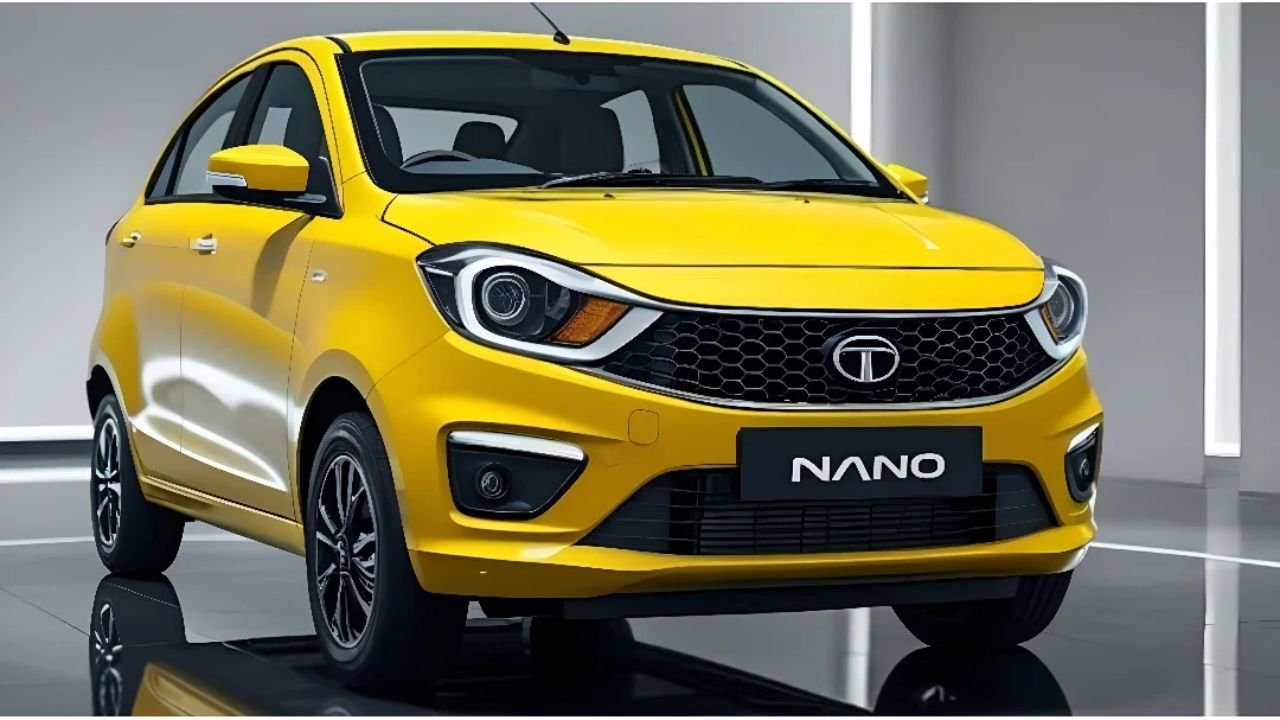New Tata Nano for Small Family in Low budget with Premium Features and Five Star Rating Safety, The New Tata Nano represents more than just a compact car—it symbolizes a bold automotive experiment that captured global attention. When Tata Motors first introduced the Nano in 2008, it was dubbed the “people’s car,” a revolutionary idea that made headlines for being the world’s cheapest car. With a launch price of approximately ₹1 lakh (around $2,000), the Tata Nano was designed with a singular vision: to make car ownership accessible to the average Indian family. Though its production ended in 2018, the legacy of the Tata Nano still resonates in the hearts of millions who witnessed this game-changing vehicle.
In this article, we’ll explore the full story of the New Tata Nano—its inception, features, unique design, challenges, and lasting impact on the automotive industry.
The Vision Behind the New Tata Nano
The concept of the Tata Nano came from Ratan Tata’s desire to provide a safer and more affordable mode of transportation for Indian families who relied on two-wheelers. Seeing families squeezed onto motorcycles in busy Indian cities sparked the idea of creating a low-cost car that could fit four people, provide weather protection, and offer basic comforts.
Unlike luxury or performance vehicles, the New Tata Nano focused on practicality, efficiency, and affordability. Tata Motors envisioned a car that could change the lives of millions by putting them behind the wheel for the first time.
Key Specifications of the Tata Nano
Before diving deeper, let’s take a look at the technical specs and key features that defined the New Tata Nano:
| Category | Details |
|---|---|
| Manufacturer | Tata Motors |
| Launch Year | 2008 |
| Initial Price | ₹1 lakh (approx. $2,000 at the time) |
| Engine Type | 624cc, 2-cylinder petrol engine |
| Fuel Efficiency | 20–25 km/l (47–59 mpg) |
| Seating Capacity | 4 people |
| Top Speed | Around 100 km/h (62 mph) |
| Notable Features | Compact size, rear engine, lightweight frame |
| Advanced Options | AC and power windows in higher trims |
| Production End | 2018 |
| Legacy | World’s cheapest car and a milestone in Indian auto history |
What Made the Tata Nano So Unique?
At first glance, the New Tata Nano was a modest-looking hatchback, but its true value lay in the boldness of its idea. Its minimalist yet efficient design allowed Tata Motors to cut down production costs while still offering a viable four-wheeler alternative to the masses. With a rear-mounted engine, compact footprint, and fuel-efficient performance, the Nano redefined what an entry-level car could look like.\
Families who once relied on scooters could now enjoy the convenience and safety of a car—no more getting soaked in the rain or cramming onto two wheels. The Tata Nano delivered freedom and dignity, all while being easy on the wallet.
Practical Features for Daily Use
While it wasn’t built to turn heads or win drag races, the New Tata Nano had plenty of features that made it practical for everyday use:
- Excellent Fuel Economy: With a mileage of 20–25 km/l, the Nano was extremely cost-effective for daily commuting.
- Compact Dimensions: The small size made parking and maneuvering through narrow streets a breeze—perfect for India’s congested urban centers.
- Simple Dashboard: The early models had basic instrument panels, but later variants included AC, music systems, and even power windows.
- Surprisingly Roomy Cabin: Though tiny on the outside, the Nano’s interior could comfortably seat four adults.
- Low Maintenance Costs: The minimal mechanical complexity meant fewer breakdowns and cheap repair costs.
All these features made the New Tata Nano a sensible choice for first-time car buyers or small families looking to upgrade from two-wheelers.
The Public Perception: A Double-Edged Sword
Despite its groundbreaking affordability, the Nano struggled with public perception. In trying to be the cheapest car in the world, it inadvertently got labeled as a “poor man’s car.” This tag hurt its appeal among aspirational buyers who wanted status as much as functionality.
Also, early media coverage surrounding a few isolated fire incidents created doubts about safety. Although Tata Motors responded quickly by upgrading components and improving safety features, the damage to the brand’s reputation had already been done.
The idea was visionary, but the emotional and social appeal didn’t match up with rising consumer expectations, especially as India’s middle class became more brand-conscious and lifestyle-driven.
Market Challenges Faced by the Tata Nano
Several challenges contributed to the Nano’s decline, despite its innovative design and low price:
1. Image Problems
Being known as the “cheapest car” backfired in a market where many buyers seek products that elevate their social standing. Consumers wanted value, but not at the cost of prestige.
2. Changing Market Dynamics
As incomes grew, more Indians began opting for better-equipped hatchbacks and compact sedans that offered enhanced features and brand appeal.
3. Lack of Upgrades
The Nano failed to evolve significantly over time. Competitors like the Maruti Alto and Hyundai Eon continuously improved their offerings, while the Nano remained largely the same with minor facelifts.
4. Production and Dealership Gaps
Also Read : New Maruti Ertiga 2025 comes with a dangerous look, see the price with smart features
The New Tata Nano was initially produced at a plant in Singur, West Bengal, but political issues forced Tata Motors to shift operations to Gujarat. This disrupted early momentum and delayed mass production.
The End of Production: Saying Goodbye to a Dream
Despite its enormous potential and ambitious goals, Tata Motors officially ceased production of the New Tata Nano in 2018. That year, only one unit was produced in some months, reflecting the plummeting demand.
Tata’s decision to discontinue the model wasn’t just a business call—it marked the end of one of the boldest chapters in India’s automotive history. However, the Nano’s influence remains. It inspired future budget cars and proved that innovation doesn’t always have to come at a high price.
Will There Be a Comeback for the New Tata Nano?
In recent years, rumors have surfaced about a reimagined electric version of the Tata Nano. With India’s growing focus on electric vehicles (EVs) and sustainability, the concept of a compact, affordable EV under the New Tata Nano brand could be the comeback story everyone’s waiting for.
Some reports have even hinted that Tata Motors is exploring partnerships to launch a new-age Nano EV—lightweight, emission-free, and tech-enhanced for urban users.
FAQs About the New Tata Nano
Q1: How many people could the Tata Nano seat?
The car was designed to seat four adults comfortably, making it ideal for small families or couples.
Q2: What was the mileage of the Tata Nano?
It offered impressive fuel efficiency—between 20 to 25 km per liter, which made it one of the most economical cars in India during its time.
Q3: Is the Tata Nano still available for purchase?
No, the Nano was discontinued in 2018 due to poor sales and lack of demand. However, used models can still be found in the pre-owned car market.
Q4: Was the Tata Nano safe?
While the early versions raised concerns, later models were improved for better safety. Still, it wasn’t meant to compete with premium cars in terms of crash protection—it was focused on affordability and basic safety.
Q5: Will Tata Nano make a comeback as an electric car?
While there is no official confirmation yet, the idea of a New Tata Nano electric version continues to stir excitement. Given the current EV trend, such a launch wouldn’t be surprising in the future.
Conclusion: The Legacy of the New Tata Nano
The New Tata Nano may not have become a commercial blockbuster, but it succeeded in disrupting conventional thinking about mobility. It opened up a new segment in the automobile industry—ultra-affordable cars—and brought thousands of Indian families into the four-wheeler club.
More than just a car, the Nano was a symbol of innovation, frugality, and social progress. Its journey reminds us that even the most ambitious dreams can hit roadblocks, but the effort to think differently always leaves a lasting impact.
In the world of automotive history, the New Tata Nano will always be remembered not just for being the cheapest car, but for being the car that dared to dream big.
Some Important Link
| Telegram Group | Click Here |
| WhatsApp Group | Click Here |
| Home Page | Click Here |















